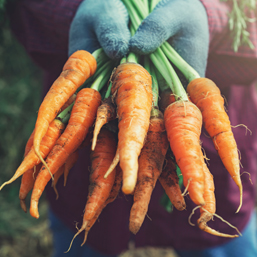
“Mom, was this cracker ever alive?”
It occurred to me at that moment - when we were sitting around the lunch table and my then 6-year-old daughter asked me this question - that perhaps I could do a better job teaching my kids where their food comes from.
As a city girl myself, the only thing I knew about agriculture was the field trip tours of farms that I took in school as a child and the information I have collected from talking to farmers and ranchers over my years as
a journalist.
The “cracker question” (as it has become known in our household) came up last spring and instead of just laughing it off as a funny thing kids say, it spurred my husband and I to take action.
We decided to trade in our neighborhood grocery store for a local fresh food market, a garden, and a working ranch as our main sources of food over the spring/summer months. We use our weekly trips to these locations to teach our children where the food they eat comes from and how it gets from the land to their plate.
Down to Earth
This is an important lesson for a number of reasons, according Nicola Doherty, marketing coordinator of
Open Farm Days.
“There's a multitude of reasons for kids to not just know where their food comes from, but also to understand the process of producing their food, such as the benefits of fresh food, and an appreciation of how long it takes to grow their food,” Nicola says.
Open Farm Days is a two-day event happening across Alberta on August 13 and 14, where farms across the province open up their doors to their rural and urban neighbors to demonstrate farming in the province.
Nicola adds that for children that don't have the opportunity to visit a farm, their conception of where food comes from is often related to the grocery store.
“While grocery stores are an important part of a family’s food story, connecting children to the beginning of the food story such as talking about collecting eggs, harvesting wheat to turn into flour or pulling a carrot out of the dirt, is important as the lessons we teach children about cooking food or healthy choices.”
When you live in a city of more than 1 million people, what are some ways you can bring the farm into your children’s food?
Meaningful markets
Nicola says local farmers markets are a great place to start when exposing children to natural foods. When browsing the stands at a market, it is easy to start the conversation about where the food on the shelves came from and how it got there.
“Often times when you're shopping at a farmers market you are buying directly from the farmer that produced the product,” Nicola says. “It's a concrete way for children to see the big picture in food production.”
A ranch is another great place to bring your little ones so they can get an idea of how an animal can provide food for us. “When you're bringing your kid to a ranch, you're again, giving the child the big picture of food production,” says Nicola. “Steaks and burgers and chicken don't magically appear at the grocery store. Visiting a local ranch, however, you can see how the ranchers
look after the animals, how the animals live,
and what the animals eat, and the cycle of life.”
Incorporating local food into your daily meals can be easier than you would think, and it's fun to try to see if your family can eat “Alberta” for a meal a week.
Farm fresh
Farms and ranches are a sensory experience, so visiting a farm at an early age is a great idea.
Christina Stender, farmer and owner of Eh Farms, says she feels it is important for everyone to know where their food comes from, but it is especially crucial for children.
“Kids often don't understand the care and commitment that goes into the food they love,” she says.
“Knowing the importance allows kids to appreciate and value their food in a different way and teaches them to not take it for granted. I think it's important for everyone to know that food doesn't come from the grocery store, it starts months or years before with a farmer and a farm.”
Eh Farms is a pig farm that specializes in the Red Mangalitsa breed and has been in operation since 2017. Christina says since they have opened, they have offered the public the chance to come out and meet their farm friends.
“Many don’t understand the dedication and care that goes into raising livestock,” she says. “Sharing my story, I hope to educate everyone about life on the farm and the vital role agriculture plays in their lives.”
When my family goes to pick up our meat from the local ranch we visit, my kids are absolutely enthralled with everything from the farm dog and cats, to the cows, chickens and even the silos and other farm equipment.
Every time we visit, they come up with interesting and thoughtful questions about agriculture and the farming process that we often need to ask an employee at the ranch about or go home and look up the answer to.
“Depending on the farm, and the time of year they visit a farm, each visit can be new with each new seasonal vegetable, visiting the lambs or calves in the early spring or wearing a bee suit to experience beekeeping in the summer,” says Nicola.
She adds that agriculture is very varied across the province and includes everything from orchards, to bison ranches and apiaries. CCM
Connecting kids with their food source empowers them to know what they're eating and the people and farms that make it possible for them to eat delicious food.
Local Farmers Markets:
Calgary’s Child Magazine © 2024 Calgary’s Child